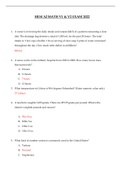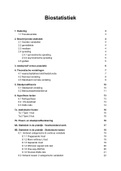Chapter 2 — A Tour of the Book
Ways to Explain Economics:
• Verbal Explanation (with words)
• Graphical Explanation/Analysis
• Quantitative/Mathematical Explanation/Analysis (models, calculations, etc)
Aggregate Output
• The measure is called gross domestic product (GDP).
• GDP is the value of the nal goods and services produced in the economy during
a given period. We count only nal goods, not intermediate ones.
• GDP is the sum of incomes in the economy during a given period. Because
aggregate production and aggregate income are always equal.
• Nominal GDP is the sum of the quantities of nal goods produced times their
current price.
• Nominal GDP increases for two reasons:
◦The production of most goods increases over time.
◦The price of most goods increases over time.
• Real GDP is the sum of quantities of nal goods times constant (not current)
prices.
BYE
• Nominal GDP is also called dollar GDP, or GDP in current dollars.
• Real GDP is also called GDP in terms of goods, GDP in constant dollars, GDP
adjusted for in ation, or GDP in chained (2012) dollars, or GDP in 2012 dollars.
• GPD will refer to real GDP.
• Yt will denote real GDP in year t.
• Nominal GDP and variables in current dollars will be denoted by a dollar sign in
front of them like $Yt.
• GDP growth in the year is (Yt - Yt-1)/Yt-1
,The Unemployment Rate
• Employment is the number of people who have a job.
• Unemployment is the number of people who do not have a job but are looking for
one.
◦A person is unemployed if he or she does not have a job and has been looking
for a job in the last four weeks.
◦Those who do not have a job and are not looking for one are counted as not in
the labor force.
• Discouraged workers are those persons who give up looking for a job and so no
longer count as unemployed.
• The participation rate is the ratio of the labor force to the total population of
working age.
◦Because of discouraged workers, a higher unemployment rate is typically
associated with a lower participation rate.
• The labor force is the sum of employment and unemployment.
• L (labour force) = N (employment) + U (unemployment)
• Unemployment rate = U/L
• Unemployment is an important data because:
◦It has a direct e ect on the welfare of the unemployed, especially those
remaining unemployed for long periods of time.
◦It is a signal that the economy is not using its human resources e ciently.
◦Very low unemployment can also be a problem as the economy runs into labor
shortages.
The In ation Rate
• In ation is a sustained rise in the price level.
• The in ation rate is the rate at which the price level increases.
• De ation is a sustained decline in the price level (negative in ation rate).
• The GDP de ator in year t (Pt) is the ratio of nominal GDP to real GDP in year t:
Nominal GDPt/Real GDPt = $Yt/Yt
• It is called an index number (1 in 2012), which has no economic interpretation.
• The rate of change has a clear interpretation: the rate of in ation.
• Nominal GDP is equal to the GDP de ator times real GDP. ($Yt = PtYt)
• So, the rate of growth of nominal GDP is equal to the rate of in ation plus the rate of
growth of real GDP.
• The set of goods produced in the economy is not the same as the set of goods
purchased by consumers because:
◦Some of the goods in GDP are sold not to consumers but to rms, to the
government, or to foreigners.
◦Some of the goods bought by consumers are not produced domestically but are
imported from abroad.
fl
fl
,• The Consumer Price Index (CPI) is a measure of the cost of living. It gives the cost
in dollars of a speci c list of goods and services over time.
• The in ation rates, computed using either the CPI or the GDP de ator, are largely
similar:
• The CPI and GDP de ator moved together most of the time.
• Exception: In 1979 and 1980, the increase in the CPI was signi cantly larger than
the increase in the GDP de ator due to the price of imported goods increasing
relative to the price of domestically produced goods.
• Pure in ation is proportional increase in all prices and wages.
◦This type of in ation causes only a minor inconvenience as relative prices are
una ected.
◦Real wage (wage measured by goods rather than dollars) would be una ected.
◦There is no such thing as pure in ation in reality.
• Economists care about in ation because:
◦In ation a ects income distribution when not all price and wages rise
proportionally.
◦In ation leads to distortions due to uncertainty, some prices that are xed by law
or by regulation, and its interaction with taxation (bracket creep in taxes).
◦Most economists believe the “best” rate of in ation to be a low and stable rate o
in ation between 1 and 4%. The FED’s goal is 2% while Turkey’s is 5%.
The Short Run, the Medium Run and the Long Run
• Short run —> Year to year, few years
◦Depends on the demand.
• Medium run —> A decade
◦Depends on the supply factors. (the capital stock, the level of technology and th
size of labour force)
• Long run —> A few decades or more
◦Depends on the ability to innovate new technologies and how much people save
the quality of the county’s education system, etc.
fl
fl fi
, Chapter 3 — The Goods Market
The Composition of GDP
• Consumption —> C
• Investment —> I
• Government spending —> G
• Exports —> X
• Imports —> IM
• Net exports / trade balance —> X - IM
◦X > IM —> Trade surplus
◦IM > X —> Trade de cit
• Inventory investment: Di erence between production and sales
The Demand for Goods
• Z (the total demand for goods) = C + I + G X - IM
• In a closed economy, X = IM = 0, Z = C + I + G.
• Consumption (C) is a function of disposable income (YD), the income remains once
consumers have received government transfers and paid their taxes. (C = C(YD)) is
the consumption function. It is also a behavioural function captures the behaviour
of consumers.
• Let’s say we have c0 and c1, C = c0 + c1YD.
• c1 is propensity to consume while c0 is what people would consume if their
disposable income equals zero.
• Changes in c0 changes in consumption habits.
• Y —> Income
• T —> Taxes
• YD (disposable income) —> Y - T
• So, C = c0 + c1(Y - T).
Ways to Explain Economics:
• Verbal Explanation (with words)
• Graphical Explanation/Analysis
• Quantitative/Mathematical Explanation/Analysis (models, calculations, etc)
Aggregate Output
• The measure is called gross domestic product (GDP).
• GDP is the value of the nal goods and services produced in the economy during
a given period. We count only nal goods, not intermediate ones.
• GDP is the sum of incomes in the economy during a given period. Because
aggregate production and aggregate income are always equal.
• Nominal GDP is the sum of the quantities of nal goods produced times their
current price.
• Nominal GDP increases for two reasons:
◦The production of most goods increases over time.
◦The price of most goods increases over time.
• Real GDP is the sum of quantities of nal goods times constant (not current)
prices.
BYE
• Nominal GDP is also called dollar GDP, or GDP in current dollars.
• Real GDP is also called GDP in terms of goods, GDP in constant dollars, GDP
adjusted for in ation, or GDP in chained (2012) dollars, or GDP in 2012 dollars.
• GPD will refer to real GDP.
• Yt will denote real GDP in year t.
• Nominal GDP and variables in current dollars will be denoted by a dollar sign in
front of them like $Yt.
• GDP growth in the year is (Yt - Yt-1)/Yt-1
,The Unemployment Rate
• Employment is the number of people who have a job.
• Unemployment is the number of people who do not have a job but are looking for
one.
◦A person is unemployed if he or she does not have a job and has been looking
for a job in the last four weeks.
◦Those who do not have a job and are not looking for one are counted as not in
the labor force.
• Discouraged workers are those persons who give up looking for a job and so no
longer count as unemployed.
• The participation rate is the ratio of the labor force to the total population of
working age.
◦Because of discouraged workers, a higher unemployment rate is typically
associated with a lower participation rate.
• The labor force is the sum of employment and unemployment.
• L (labour force) = N (employment) + U (unemployment)
• Unemployment rate = U/L
• Unemployment is an important data because:
◦It has a direct e ect on the welfare of the unemployed, especially those
remaining unemployed for long periods of time.
◦It is a signal that the economy is not using its human resources e ciently.
◦Very low unemployment can also be a problem as the economy runs into labor
shortages.
The In ation Rate
• In ation is a sustained rise in the price level.
• The in ation rate is the rate at which the price level increases.
• De ation is a sustained decline in the price level (negative in ation rate).
• The GDP de ator in year t (Pt) is the ratio of nominal GDP to real GDP in year t:
Nominal GDPt/Real GDPt = $Yt/Yt
• It is called an index number (1 in 2012), which has no economic interpretation.
• The rate of change has a clear interpretation: the rate of in ation.
• Nominal GDP is equal to the GDP de ator times real GDP. ($Yt = PtYt)
• So, the rate of growth of nominal GDP is equal to the rate of in ation plus the rate of
growth of real GDP.
• The set of goods produced in the economy is not the same as the set of goods
purchased by consumers because:
◦Some of the goods in GDP are sold not to consumers but to rms, to the
government, or to foreigners.
◦Some of the goods bought by consumers are not produced domestically but are
imported from abroad.
fl
fl
,• The Consumer Price Index (CPI) is a measure of the cost of living. It gives the cost
in dollars of a speci c list of goods and services over time.
• The in ation rates, computed using either the CPI or the GDP de ator, are largely
similar:
• The CPI and GDP de ator moved together most of the time.
• Exception: In 1979 and 1980, the increase in the CPI was signi cantly larger than
the increase in the GDP de ator due to the price of imported goods increasing
relative to the price of domestically produced goods.
• Pure in ation is proportional increase in all prices and wages.
◦This type of in ation causes only a minor inconvenience as relative prices are
una ected.
◦Real wage (wage measured by goods rather than dollars) would be una ected.
◦There is no such thing as pure in ation in reality.
• Economists care about in ation because:
◦In ation a ects income distribution when not all price and wages rise
proportionally.
◦In ation leads to distortions due to uncertainty, some prices that are xed by law
or by regulation, and its interaction with taxation (bracket creep in taxes).
◦Most economists believe the “best” rate of in ation to be a low and stable rate o
in ation between 1 and 4%. The FED’s goal is 2% while Turkey’s is 5%.
The Short Run, the Medium Run and the Long Run
• Short run —> Year to year, few years
◦Depends on the demand.
• Medium run —> A decade
◦Depends on the supply factors. (the capital stock, the level of technology and th
size of labour force)
• Long run —> A few decades or more
◦Depends on the ability to innovate new technologies and how much people save
the quality of the county’s education system, etc.
fl
fl fi
, Chapter 3 — The Goods Market
The Composition of GDP
• Consumption —> C
• Investment —> I
• Government spending —> G
• Exports —> X
• Imports —> IM
• Net exports / trade balance —> X - IM
◦X > IM —> Trade surplus
◦IM > X —> Trade de cit
• Inventory investment: Di erence between production and sales
The Demand for Goods
• Z (the total demand for goods) = C + I + G X - IM
• In a closed economy, X = IM = 0, Z = C + I + G.
• Consumption (C) is a function of disposable income (YD), the income remains once
consumers have received government transfers and paid their taxes. (C = C(YD)) is
the consumption function. It is also a behavioural function captures the behaviour
of consumers.
• Let’s say we have c0 and c1, C = c0 + c1YD.
• c1 is propensity to consume while c0 is what people would consume if their
disposable income equals zero.
• Changes in c0 changes in consumption habits.
• Y —> Income
• T —> Taxes
• YD (disposable income) —> Y - T
• So, C = c0 + c1(Y - T).











